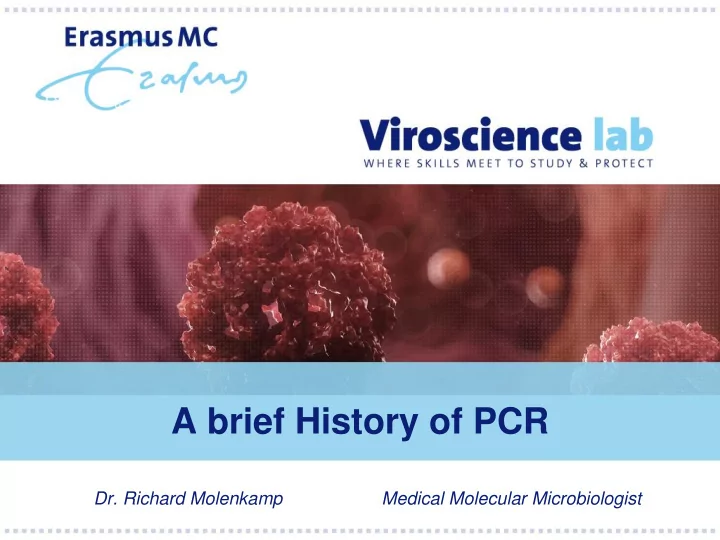

A brief History of PCR Dr. Richard Molenkamp Medical Molecular Microbiologist
Structure of DNA
Visualisation of DNA I Staining Hybridisation Direct
Visualisation of DNA II Small amounts of signal: Need amplification PCR: Polymerase Chain Reaction
Principle of PCR Conventional thermocycle profile:
Exponential amplification Number of cycli on an agarose gel: 10 15 20 25 30 35 40
Early PCR Addition of polymerase in each cycle Breakthrough: Thermostable (Taq) polymerase Integrated Thermocyclers
Conventional PCR = End point analysis no quantitative data Real-time PCR
Sybrgreen reactions - Intercalating fluorescence DNA Target Sequence Denaturation Drawback: a-specifc product also fluoresent!
Lens Dichrome Mirror MUX LASER Sample block Lens Spectrograph CCD camera
Amplification curves
Sybrgreen reactions – melting curve analysis
Detection Formats (I) Probe-based - Taqman technology: specific double-dyed fluorescent hydrolysis probes - FRET (Fluorescence Resonance Energy Transfer): hybridisation probes - Partially double stranded, single-dyed, hybridisation probes R R Q Q – Long target-specific probe w – – – – –
Excitation / emission of fluorophores TAMRA quenching Fluorescence Deep Dark/Black hole quenchers
5’ Nuclease Assay / Taqman assay F = reporter FAM, VIC, Hex … Q = quencher Black hole quencher (BHQ)….
Hybridization probes or FRET probes
Partially double stranded linear DNA probes R R Q Q – Long target-specific probe with fluor – Short quencher probe – Fluorescence quenched when probes are hybridized – Long probe preferentially binds target – Short quencher probe is dissociated – Fluorescence is detected Excitation Excitation Emission Emission R
Probe free: MultiCode technology (I) MultiCode Base Pair (isoC:isoG) Iso C Iso G Scott C etal, Nucl. Ac. Res. 2004
MultiCode PCR (II)
MultiCode technology
Ct / Cp / Cq Calling
Ct calling I PCR positivity measured at Cycle threshold (Ct)-level Fluorescence Threshold Cycle Background fluorescence 10x SD background 10 30 0 20 Number of cycles
Ct calling II PCR positivity measured at Cycle threshold (Ct)-level Fluorescence Threshold Cycle Background fluorescence 10x SD background 20 10 30 0 Number of cycles
Cp calling I PCR positivity measured 2 nd derivative max. Fluorescence Crossing point Calculates 2nd derivative and determines its maximum. Background fluorescence CP: Where the rate of increase of fluorescence is greatest 10 30 0 20 Number of cycles
Cp calling II PCR positivity measured 2 nd derivative max. Fluorescence 10 30 0 20 Number of cycles
Quantification
Quantification with real-time PCR
Principles of quantification – real time PCR Calculation of efficiency
Reverse transcription PCR
Reverse transcription PCR Mix of RT and PCR enzyme: M-MLV / Taqgold Enzyme with RT and DNA pol activity rTth
Sequence variation Influences design of PCR PCR can be used to detect variation
HIV-1 group M sequence variation in Gag and Pol genes
Influence of mismatches on hybridization temperature Length 27 nt GC content 60% Tm 69 ºC tgggaggttctctccagcactagcagg Tm 62.6 ºC tgggaggttctctccagcactagcagg a t Tm 57.8 ºC tgggaggttctctccagcactagcagg a t a
How to deal with sequence variation Degenerate oligos GGTAYCCATGRTCAG IUB codes R = A or G Y = C or T Dual target assay Dual probe assay
Dual target real time PCR Genome HIV 5’ - - 3’ Integrase LTR If there is a mutation in either of the primer/probe sites the other PCR will ‘take over‘
Realtime PCR for detection of single mutations Conventional Sanger sequencing: ~25% Sensitive methods: LIPA/DNA microarray (hybridisation) 5-10% Allele-specific PCR ~5% Next generation sequencing (0.5% ?) Quantitative real-time techniques: 1-10% LNA/MGB probes (short high affinity probes) Digital PCR
Probes used for detection of single mutations (I) Minor groove binding probes Locked nucleic acid probes • Due to higher affinity binding shorter probes can be defined • Taqman probes are 22-30 nt long; LNA/MGB probes 8-20 nt long
Hybridization temperature: effect in MGB and LNA probes Length 27 nt tgggaggttctctccagcactagcagg Tm 69 ºC tgggaggttctctccagcactagcagg Tm 62.6 ºC a t tgggaggttctctccagcactagcagg Tm 57.8 ºC a t a Length 17 nt GGAGG(+T)T(+C)TCT(+C)CAG(+C)A Tm 69 ºC GGAGG(+T)T(+C)TCT(+C)CAG(+C)A Tm 59 ºC A
Detection of oseltamivir resistant influenza A/H1N1 H274Y by real-time discrimination PCR using LNA probes T (mut) NA: 5’atcgaaaagggaaaggttactaaatcaatagagttaaatgcacccaatttt C attatgaggaatgttcctgttacccagacactggc 3’ LNA:H274Y N1274Yfpr1 N1274Yrpr1 (30bp) (24bp) LNA:H274H (16bp) Mutant cluster + control + control Wild-type cluster + control + control NTC NTC
Detection of lamivudine resistance in HBV Pas et al., Journal of Clinical Virology 32 (2005) 166 – 172
Effect of (enzyme) mastermix on mismatch tolerance
Influence of mastermix on primer bindingsite mismatch tolerance > 50 different mutants Stadhouders et al., J. Mol. Diag., 2010
Primer bindingsite mismatch tolerance
Influence of mastermix on primer bindingsite mismatch tolerance MMLV / Taqgold combination (ABI): RT @ 48°C
Influence of mastermix on primer bindingsite mismatch tolerance rTth based mastermix: RT@60°C
Digital PCR Fluidigm Biorad QX200 droplet PCR Raindance technologies Quant studio
Principle of digital PCR (dPCR) Limited dilution Poisson distribution 0 0.368 1 0.368 2 0.184 3 0.061 4 0.015 5 0.003 >5 0.001
1 1. Manual dilution 2. Droplet PCR (ddPCR, Biorad) 2 3. Lab on a chip (Lifetechnologies) 3 4. Microfluidics (Fluidigm) 4
Applications of dPCR Rare sequence / mutation detection (oncology, virology drug resistance) Copy number quantification (standardisation controls) Low level pathogen detection (in difficult samples) Gene-expression (absolute quant. of (un)stimulated) gene expression)
Questions ?
Recommend
More recommend